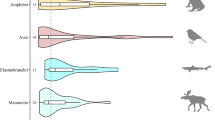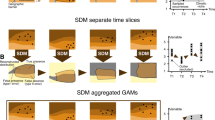Abstract
BIOLOGISTS have long been interested in the dynamics of living populations of animals, but for obvious reasons they have been less concerned with the nature of the resulting dead populations. Recently, palaeontologists1,2 have begun to investigate the dynamics of living populations and their transformation into fossil communities. It is now possible to complement these studies with mathematical models which define the form of a stable living population and its accumulating fossil counterpart. The processes of recruitment, growth, seasonality and mortality have been programmed for an ‘IBM 7094’ computer and the output expressed in terms of age-frequency and size-frequency for the living and resulting dead populations.
This is a preview of subscription content, access via your institution
Access options
Subscribe to this journal
Receive 51 print issues and online access
$199.00 per year
only $3.90 per issue
Buy this article
- Purchase on Springer Link
- Instant access to full article PDF
Prices may be subject to local taxes which are calculated during checkout
Similar content being viewed by others
References
Olson, E. C., J. Geol., 65, 309 (1957).
Craig, G. Y., and Hallam, A., Palaeontology, 6, 731 (1963).
Author information
Authors and Affiliations
Rights and permissions
About this article
Cite this article
CRAIG, G., OERTEL, G. Models of Living and Fossil Populations of Animals Generated by a Computer. Nature 210, 438–439 (1966). https://doi.org/10.1038/210438a0
Issue Date:
DOI: https://doi.org/10.1038/210438a0
This article is cited by
Comments
By submitting a comment you agree to abide by our Terms and Community Guidelines. If you find something abusive or that does not comply with our terms or guidelines please flag it as inappropriate.



